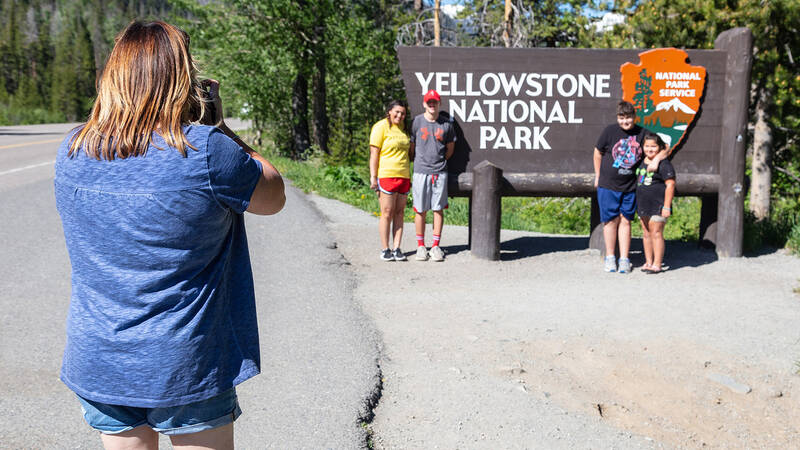We love national park photos, but posed images can’t tell the whole story — especially years later. An award-winning documentary photographer shares how to turn your family adventure into cherished memories.
Imagine two photographs from a recent national parks trip. One captures your family posed together and smiling by a park entrance sign, a gorgeous vista in the background. The other, a little blurry, captures a commotion: your partner stumbling up a hill, carrying your child and a mess of gear, while your dog gets tangled in the leash behind her.
In 10 years, which image is more likely to conjure up memories of your national park adventure?
Laura Beth Davidson, an award-winning documentary family photographer, will choose the blurry tangled leash image every time for its action, reaction and unfiltered detail.
“Our memories are so unreliable,” she said. “But if you photograph honest, seemingly mundane moments, you’ll capture details that transport you right back to a specific time and place.” It’s one of the guiding principles of documentary photography — tell it real — and it can help you turn lived experience into long-treasured family history.
For example, the image with the wayward dog leash may call to mind that your 5-year-old was more worried about her “Dogman” book than the fate of her actual pet. Or that later that day, your partner lost one of her Chacos, thanks to some ill-fated rock hopping. Or that over the hill, the air smelled of pine and campfire smoke. The memories that such chaotic pictures evoke are rich and real — the stuff of family stories.
“Strip away the perfect poses and smiles and what’s left is your story. … And that’s beautiful … that is worth remembering.”
The classic postcard shot posed by the entrance sign isn’t a bad picture, Davidson said. After all, it captures a family experience, albeit a choreographed one. Just don’t expect “everybody smile!” images to do much heavy lifting when you want to recall your trip in the future. A “proof of life” image only records superficial details: hair and clothing styles, for example, or the weather.
Davidson encourages candid photos that fill in the details and record the full story of your trip, beautiful and mundane. “Give yourself a robust experience of remembering,” Davidson said.

A conventional family photo at Yellowstone National Park’s east entrance.
NPS/Jacob W. FrankMany of us (this writer included!) tend to approach vacation photos like a sort of highlight reel. But to reap the benefits of documentary photography, Davidson suggests a shift in mindset. “Think about creating a souvenir,” she advised. “The word ‘souvenir’ has Latin roots that mean ‘to come up from below.’ So, take pictures that will call up details from your murky memory and transport you to the experience your family — and nobody else’s — had in the national park.”
If you’d prefer a professional eye, you can hire a documentary family photographer to join you for part of your national park adventure. But if you are the designated documentarian, get your shutter finger ready. Here are Davidson’s best tips for creating a memorable national park souvenir.
1. Get to know your tech.
Before you leave, master your camera settings. And if your camera is your phone, feel confident that it’s a good choice. Davidson reassures us that a phone is great for documentary photographer. “And it’s a bonus that it fits in your pocket,” she said.
Davidson recommends maximizing the phone’s flexibility: Learn how to focus on foreground and background, work the video feature, and access the camera quickly to capture fleeting moments. Don’t forget that you can hold your phone in either portrait mode or landscape mode (sideways). Switch it up when the occasion calls for it.
2. Put yourself in the landscape.
Anyone can snap a picture of Half Dome in Yosemite. But what image will capture your experience of an iconic view? Davidson recommends making landscapes memorable by layering in sensory cues. Instead of just snapping Half Dome, take a few steps back and include your tent or your backpack, your kids’ muddy boots, or your hand holding a steaming cup of coffee in the foreground.
“The more specifics you include, the quicker your brain can get back to that place — that campsite with the muddy riverbank, that year when they wore those boots, that morning you were so glad for coffee,” she said.
3. Don’t miss the in-between moments.
Maybe your family is hiking the trail to a famous view. Making dinner. Writing postcards. Bickering in the car. Slathering on sunscreen. Those liminal times are rich with opportunity to capture personality and quirks you’ll want to remember.
“Seemingly mundane moments are an invitation to play with scale,” Davidson said. “In the middle of a national park’s bigness, lean in close to capture untied shoes and grubby fingers holding shiny rocks. Or step back to capture a sense of smallness amidst the grandeur.”
4. Capture people in action.
Any story worth its salt has action, big or small, right? So, as you’re weaving your family’s story through pictures, don’t forget to capture people doing stuff. Document the park-specific things, of course — climbing or paddling or exploring. But also document your partner rolling up sleeping bags, your teen texting, the whole crew perusing the gift shop, your 7-year-old spouting volcano knowledge, your toddler buttoning their coat.
“A picture of skewering hotdogs isn’t art. But in concert with everything else, those small actions are what make the trip what it is, and photos of that will help call it back to memory later,” Davidson said.
5. Document the full range of emotion.
Every trip — every day, really — has conflict and resolution. It may be minor … or perhaps major. Either way, it’s part of your story. Document the awe and excitement, of course — but also capture your partner’s look of panic when you miss the park shuttle, the tears of a scraped knee, the elation of having made it to the peak and the exhaustion on the drive back.
“Capture the lows, but don’t dwell on them,” Davidson advised. “You want to be able to look back and say, ‘Oh right! That happened!’ I bet you’ll remember it was worth the meltdowns to explore a national park.”
6. Make it a group project.
You can give everyone a camera or just pass around whatever camera or phone you’re using. “It’ll guarantee you different perspectives on the trip, both literally and figuratively,” Davidson said. Will your child take 12 pictures of a beetle and zero of the Grand Canyon? Maybe. But that omission, too, will take you right back to the slice of their childhood that you spent exploring a national park.
7. Transform your images into something physical.
While the cloud is convenient for storing photos, will you or your kids ever go there to revisit your adventure? The value of a physical memory that can be touched and passed around is immeasurable, according to Davidson.
And she advises, keep it simple. She recommends a photo-book maker app such as Chatbooks or Snapfish that makes the process user friendly. For a coffee-table book, try Blurb or Mixbook. Or simply print everything in 4x6 and put the prints in a shoebox or an old-school photo album. As a mom to four kids, Davidson also has a note on accessibility: “Don’t make kids worry about messing up a precious heirloom. Get something sturdy, so they can relive the trip too.”

Take Better Park Photos
It can be difficult to capture the beauty of our national parks in photos. One NPCA staffer shares tips to get more confident with your camera and make your…
See more ›Training yourself to think beyond “everybody look at me and smile!” can take some time. But to send you and your camera off with confidence, Davidson proposes a thought experiment: What if you appreciated your family’s experience in the park the same way you appreciate the park itself?
“National Parks are incredible because they’re there. They just are in the world. And nobody expects them to be curated like the Smithsonian,” she said. “What if you treat your time in the park the same way? Strip away the perfect poses and smiles, and what’s left is your story — your specific setting, your specific characters, your specific plotline. And that’s beautiful … that is worth remembering.”
Stay On Top of News
Our email newsletter shares the latest on parks.
About the author
-
 Susanna Klingenberg Contributor
Susanna Klingenberg ContributorSusanna Klingenberg is a freelance writer and editor based in Raleigh, North Carolina. She loves exploring outdoors, whether it's in her unruly vegetable garden or in the national parks.